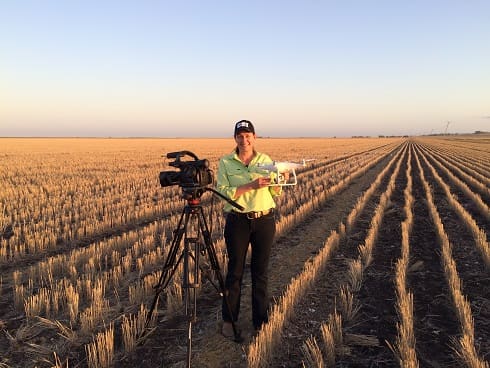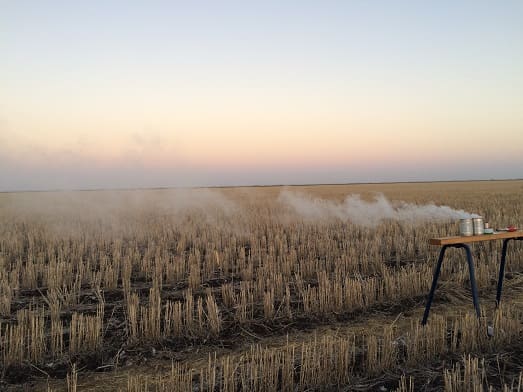Mary O’Brien says the ‘community drift’ that can occur when a number of applicators are each putting a small amount of product in the air at the same time, can have very damaging effects on off-target sites.
Ask a WeedSmart Expert
RECENT changes to 2,4-D label instructions have re-focused attention on the need to avoid night spraying, particularly after 10pm through to after sunrise.
This has raised concerns among producers and operators about the practical implications for summer weed control programs.
Mary O’Brien, a private consultant with extensive experience in managing spray drift, is keen to see growers fully adopt spray application practices that maximise herbicide efficacy and minimise off-target drift.
“The bottom line is that allowing spray to drift is like burning money,” she said.
“Any product that doesn’t hit the target is wasted and the efficacy of the spray job is reduced, mildly resistant biotypes may survive as a result of low dose application and there is potential damage to sensitive crops and the environment.
“The difficulty is that many growers want to spray at night to cover more ground when conditions are cooler and potentially weeds are less stressed. Having a restriction on night spraying does restrict the time available to cover the areas required.”
Having heard these concerns from growers across the country Ms O’Brien keeps coming back to the fact that if there was a limitation to capacity at planting or at harvest, growers would scale up to get the job done in a timely manner.
“Buying another spray rig or employing a contractor is an additional cost, especially after a couple of tough seasons, but I really think this is insignificant against the cost of losing key products and the resultant escalation in herbicide resistance to the remaining herbicides,” she said.
“This problem is not confined to 2,4-D or even to herbicides. I recently spoke to a stone fruit grower who was forced to dump his whole crop after a positive MRL return for a fungicide he had never even heard of, let alone used.”

Temperature inversion conditions are more common at night and in the early morning. These conditions generate a laminar flow of air across the landscape, allowing small droplets to travel many kilometres away from the target site before coming to ground
What about just slowing down and lowering the boom during night spraying?
Short answer: This, coupled with a good nozzle, will reduce drift but it will never eliminate it.
Longer answer: The correct ground speed and boom height will have a large effect on the amount of product that remains in the air. The problem is that it only takes 1 per cent of the product remaining in the air to cause off-target damage. Once there are a few operators putting just 1 per cent of their product in the air at the same time, the amount of product quickly accumulates and can potentially be very damaging. Ms O’Brien calls this ‘community drift’.
Isn’t it better to spray weeds at night when it’s cooler?
Short answer: Not really.
Longer answer: Research by spraying consultant Bill Gordon showed that even if you keep everything else the same, night spraying can put at least three times more product in the air than daytime application, even if weather conditions are similar and there is no temperature inversion in place. The main difference between day and night is how the wind is moving across the landscape, rather than the wind speed.
Under inversion conditions, the air moves parallel to the ground surface and this means that the product can move significant distances away from the target before coming to the ground. To achieve the best results through daytime spraying, applicators should focus on treating small, actively growing weeds. When there is good soil moisture, weeds are unlikely to be stressed, even when the temperature is quite high.
Can I use other products at night and just avoid using 2,4-D?
Short answer: The current changes to 2,4-D labels has drawn a lot of attention but the problem is the same for all crop protection sprays – herbicides, fungicides and insecticides.
Longer answer: Different products have different properties and some may work better at night but the problem is the sensitivity of some crops to certain products, such as 2,4-D. All products are tested for their efficacy and the label provides detailed information about the required spray quality and spray application conditions. Many products have explicit label instructions regarding wind speed, temperature inversions (or laminar flow) and night spraying.
Given the high risk of drift at night, applicators need to be very confident that there is no inversion present, and weather conditions should be measured at least every 15 minutes to ensure wind speed remains above 11 kilometres per hour. An on-board weather station is the best way to monitor conditions.
What can I do to improve spray efficacy and avoid spray drift?
Short answer: If you do just one thing – change your nozzle.
Longer answer: All the factors that increase drift also reduce efficacy. To improve efficacy and reduce drift, use a better nozzle (larger spray quality) and appropriate water rates (matched to spray quality and stubble load), slow down and keep the boom low. Wind is required to push product downward and onto the target, and remember that the 3–15 kilometre/hour wind speed is for day time conditions only, this does not apply at night.
Source: WeedSmart
How to ask a WeedSmart question
Ask your questions about night spraying on the WeedSmart Innovations Facebook page WeedSmartAU, Twitter @WeedSmartAU or the WeedSmart website https://weedsmart.org.au/category/ask-an-expert/
‘WeedSmart’ is an industry-led initiative that aims to enhance on-farm practices and promote the long term, sustainable use of herbicides in Australian agriculture.



HAVE YOUR SAY